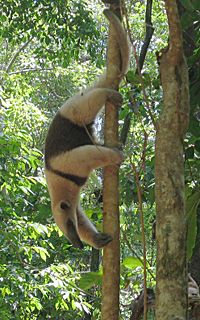Difference between revisions of "Anteater" - New World Encyclopedia
Steve Chang (talk | contribs) (added article) |
Steve Chang (talk | contribs) (added claimed) |
||
| Line 1: | Line 1: | ||
| + | {{Claimed}} | ||
| + | |||
{{otheruses}} | {{otheruses}} | ||
Revision as of 02:14, 24 September 2007
- For other uses, see Anteater (disambiguation).
| Anteaters | ||||||||||||
|---|---|---|---|---|---|---|---|---|---|---|---|---|
 Northern Tamandua
(Tamandua mexicana) | ||||||||||||
| Scientific classification | ||||||||||||
| ||||||||||||
|
Cyclopedidae |
Anteaters are the four mammal species of the suborder Vermilingua commonly known for eating ants and termites. The name is also colloquially applied to the aardvark, the numbat, the echidna, and the pangolin. Together with the sloths, they comprise the order Pilosa.
Species include the Giant Anteater Myrmecophaga tridactyla, about 1.8 m (6 ft.) long including the tail; the tamandua or collared Anteater Tamandua tetradactyla, about 90 cm (3 ft.) long; and the Silky Anteater Cyclopes didactyla, about 35 cm (14 in.) long.
Physiology
The largest extant representative of the group is the giant Anteater, or ant-bear (Myrmecophaga tridactyla), an animal measuring 4 feet (1.2 m) in length, excluding the tail, and 2 feet (60 cm) in height at the shoulder. It has a long, thin head and a large, bushy tail. Its prevailing color is gray, with a broad black band, bordered with white, starting on the chest, and passing obliquely over the shoulder, diminishing gradually in breadth as it approaches the loins, where it ends in a point. Giant Anteaters are sometimes mistaken for bears because of their claws and bushy fur. In Spanish, an anteater is referred to as an oso hormiguero, literally, "anthill bear."
It is extensively distributed in South and Central America, frequenting low swampy savannas, along the banks of rivers, and the depths of the humid forests, but is nowhere abundant.
Its food consists mainly of termites, which it obtains by opening their nests with its powerful sharp anterior (front) claws. As the insects swarm to the damaged part of their dwelling, it draws them into its mouth by means of its long, flexible, rapidly moving tongue covered with sticky saliva. A full-grown giant Anteater eats upwards of 30,000 ants and termites a day.
The giant Anteater lives above ground, not burrowing underground like armadillos or aardvarks. Though generally an inoffensive animal, when attacked it can defend itself with its sabre-like anterior claws. The female produces one offspring per birth.
During much of its first year of life, a young Anteater will ride on its mother's back. It is generally acknowledged that giant Anteaters have a poor sense of sight but a keen sense of smell. In fact, their sense of smell is regarded to be some 40 times stronger than that of humans. The name of the species, tridactyla, comes from "tri" and "dactylos", which is Greek for "three fingers". However, giant Anteaters actually have five toes on each paw (the fifth is vestigial). The name probably came about because only three of the front toes have prominent claws and can be easily seen. Giant Anteaters rarely make sounds. When they do it is mostly when they are young; the sound is a high-pitched, shrilly grunt noise. A baby that has fallen off his mother's back will grunt to its mother either to remind her that it has fallen off or to simply instruct her where it is or to get her attention.
The two Anteaters of the genus Tamandua, the Southern Tamandua (Tamandua tetradactyla) and the Northern Tamandua (Tamandua mexicana), are much smaller than the Giant Anteater, and differ essentially from it in their habits, being mainly arboreal. They inhabit the dense primeval forests of South and Central America. The usual colour is yellowish-white, with a broad black lateral band, covering nearly the whole of the side of the body.
The silky Anteater (Cyclopes didactylus) is a native of the hottest parts of South and Central America, and about the size of a rat, of a general yellowish color, and exclusively arboreal in its habits.
Both the tamanduas and the silky Anteater possess partially prehensile tails.
Classification
ORDER PILOSA
- Suborder Folivora (sloths)
- Suborder Vermilingua
- Family Cyclopedidae
- Genus Cyclopes
- Silky Anteater (Cyclopes didactylus)
- Genus Cyclopes
- Family Myrmecophagidae
- Genus Myrmecophaga
- Giant Anteater (Myrmecophaga tridactyla)
- Genus Tamandua
- Northern Tamandua (Tamandua mexicana)
- Southern Tamandua (Tamandua tetradactyla)
- Genus Myrmecophaga
- Family Cyclopedidae
Gallery
da:Myresluger de:Ameisenbären es:Myrmecophagidae eo:Formikomanĝuloj fr:Myrmecophagidae fa:مورچهخوار it:Myrmecophagidae he:דובי נמלים lt:Skruzdėdiniai nl:Echte miereneters no:Maurslukere pl:Mrówkojady pt:Tamanduá ru:Муравьеды simple:Anteater sv:Myrslokar zh:食蟻獸



